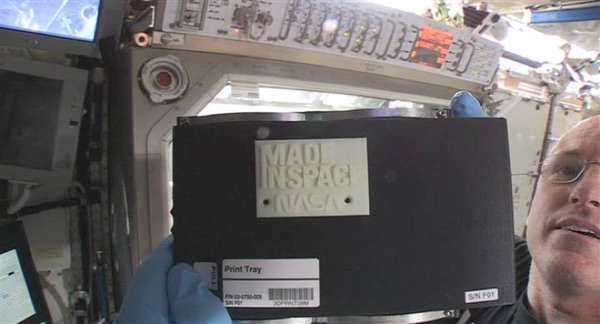The promises and perils of space-based additive manufacturingby Bhavya Lal
|
| Because components, systems, and subsystems do not have to be completely manufactured on Earth before transported to space, additive manufacturing enables development of structures entirely unlike those made in the high-gravity environment of Earth. |
In recent years, additive manufacturing has increasingly been presented as a panacea for space-based applications, touting its use to enable independence from Earth. However, the benefits and limitations of additive manufacturing in-space remained speculative, and therefore, NASA and the US Air Force commissioned the NRC to conduct a study. The NRC report 3D Printing in Space evaluated the prospects of in-space additive manufacturing, examining the various technologies available and currently in development. The report, released in July 2014, acknowledged that additive manufacturing presents potential opportunities, both as a tool in a broad toolkit of options for space-based activities and as a potential paradigm-changing approach to designing hardware for in-space activities. However, the committee that produced the report identified a number of technical challenges that must be overcome, and made specific recommendations for future research. The author was a member of this committee.
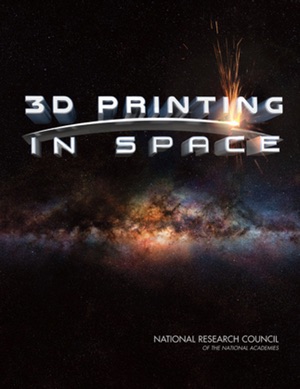 |
The vision of space-based additive manufacturing
Additive manufacturing is not just a different way to manufacture traditional components; in addition, it offers a new way to re-conceptualize space architectures. Because components, systems, and subsystems do not have to be completely manufactured on Earth before transported to space, additive manufacturing enables development of structures entirely unlike those made in the high-gravity environment of Earth, or made to survive the rigors of space launch. The committee examined seven specific applications of additive manufacturing in space.
Creating replacement components in space
As evidenced by the recently printed part on the ISS, the most immediate application of additive manufacturing in space involves the creation of replacement parts and components. Data show that a significant percentage of hardware failures on the ISS involve plastics and composites, and these may be suitable for repair using additive manufacturing techniques. Instead of carrying additional, redundant components, or waiting for them to arrive from Earth, parts can be manufactured in space as needed.
Recycling in space
Currently, ISS astronauts pack trash into robotic spacecraft, such as the Russian Progress and Orbital Sciences’ Cygnus. The spacecraft are detached from the ISS and burn up in the atmosphere. But before that happens, astronauts spend a considerable time moving the trash to get it out of the way. Additive manufacturing could use recycled materials to reduce the time and cost of waste removal.
Creating structures difficult to produce on or transport from Earth
Currently, large components and systems such as antennas, booms, and panels are designed for launch. Their delicate structures, sizes and shapes are limited by the requirement to stow them within available launch fairings. Accommodating these structures involves trade-offs between launch vehicle lift capability and shroud size. This problem is often solved by using a larger diameter shroud imposing a mass penalty. Additive manufacturing enables users to design parts for ultimate use rather than machining, manufacturing, and transporting.
Using additive manufacturing and supporting technologies in space, on-orbit construction and “erectables” technologies can enable deployment of systems that do not conform to weight and volumetric constraints posed by launch fairings and shrouds, as illustrated below. Some of the structures envisioned and supported by NASA programs like the NASA Innovative Advanced Concepts (NIAC) include ultra-thin mirrors, gossamer structures like ribbons, large antennas and arrays, reflectors, and trusses, among others.
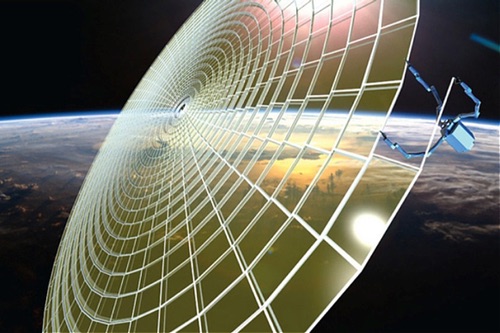 Concept of a 3D printed solar array in space. (credit: Tethers Unlimited) |
Creating sensors, sensor systems, and satellites
In a few years, as experience with both terrestrial- and space-based manufacturing improves, additive manufacturing in space could potentially enable in-space production of not just components, but also entire multi-material subsystems and systems. Experts have proposed additively manufactured production, and subsequent assembly and launch, of sensor-loaded cubesats from the ISS or other platforms in orbit.
Freeflying “Fablab”
The concept of a fabrication lab, or Fablab, was developed at the Center for Bits and Atoms at the MIT Media Laboratory to explore how the content of information relates to its physical representation. A typical Fablab is equipped with an array of flexible computer-controlled tools, often including 3D printers, with the aim to make “almost anything.” The concept of a Fablab in space is similar: users—human or robotic—would be able to access tools in space to manufacture what is needed without bringing it from Earth. An additive manufacturing capability would be the heart of such a facility. There are several free-flying spacecraft that could become available within the next decade and serve as free-flying fablabs for additive manufacturing in space.
Fully printed spacecraft
Some experts have suggested that additive manufacturing in space could create not just components but an entire spacecraft. The spacecraft could be built as a single unit with a single machine, or assembled by humans or even autonomously. How long it would take to realize this vision depends not only on technical advancements made but also on how a spacecraft is defined. A single-function spacecraft (one that, for example, only measures solar radiation during a space weather event and then degrades) is feasible on a shorter timeline than a multiple function spacecraft that is radiation-hardened, intended to last multiple years, made of multiple materials, and serves many functions.
Use of resources on planetary surfaces
Availability of construction materials like metal and water on the surfaces of the Moon, asteroids, and other celestial bodies could enable manufacturing of settlements and other facilities without having to take expensive and bulky pre-fabricated materials out of Earth’s gravitational field. Lunar regolith, for example, could be used to construct pressurized habitats for human shelter, as well as other infrastructure (e.g., landing pads, roads, blast walls, shade walls, and hangars for protection against thermal radiation and micrometeorites) on the Moon.
| In space, not only will some fundamental process-related questions that may have previously been resolved terrestrially need to be re-addressed, there will be new challenges relating to infrastructure, platforms, and the overall manufacturing approach. |
A NASA NIAC grant is exploring additive manufacturing of infrastructure (e.g., landing pads) on the Moon using simulated lunar regolith. This technique extrudes a material such as concrete layer by layer to build up structures such as walls. The European Space Agency (ESA) is funding similar research with a technology called D-Shapes to design Moon-based habitats. ESA also recently supported a workshop on 3D printing in space.
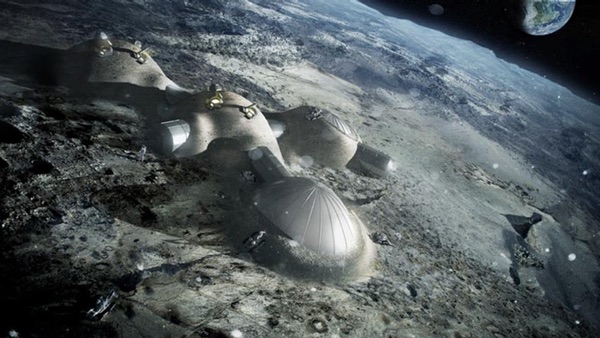 Manufacturing Habitat on Lunar Surface. (credit: Foster + Partners) |
Technical challenges to the use of additive manufacturing in space
As the initial Made in Space experiment on the ISS demonstrated, there are number of technical challenges, let alone legal and regulatory ones, that must be overcome before the technology is even close to meeting its promise. Space-based challenges are more complex than terrestrial ones, which themselves require considerable investment. In space, not only will some fundamental process-related questions that may have previously been resolved terrestrially need to be re-addressed, there will be new challenges relating to infrastructure, platforms, and the overall manufacturing approach. In addition to the constraints imposed by the space environment (e.g., zero gravity, vacuum), issues such as supply chain logistics, integrated processes, minimal human interaction, and quality control are much more pronounced in space.
Our committee identified a total of eight areas where significant effort is needed: space environment (specifically related to microgravity and vacuum); thermal environment; quality, verification, validation and functional testing; infrastructure; stability of the manufacturing platform; communication (specifically data and telemetry); power; and autonomy. The figure below summarizes the challenges, and details are available in the NRC report.
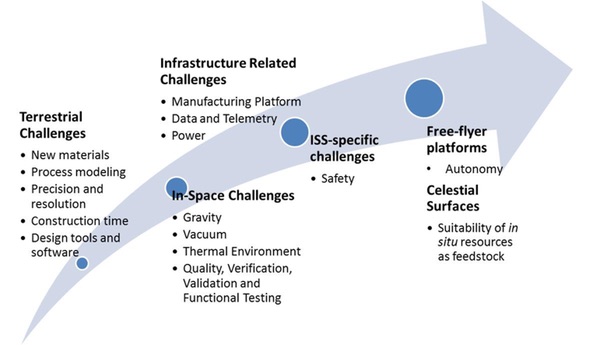 Technical Challenges to Achieving Space-Based Additive Manufacturing |
Overall findings and recommendations
The committee found that space system configurations that are currently dominated by requirements to survive ground manufacturing, assembly, test, transport, and launch could indeed be fundamentally transformed as additive manufacturing capabilities advance. At the same time, the committee also found that in space, additive manufacturing is far more of a systems engineering and industrial logistics problem compared to additive manufacturing on the ground, and as such, much needs to be done for the technology to deliver on its potential. The committee made a total of 15 recommendations to address these challenges. The recommendations fall in five general categories:
| If near-term efforts are carefully designed and executed, the application of additive manufacturing in the space environment could lead to more Earth-independent operation in space. |
Analysis. Agencies supporting space-based additive manufacturing need to perform cost-benefit analyses related to its value in space. The analyses should focus not just on how additive manufacturing could replace traditional manufacturing, but how it can enable entirely new functionalities that were not possible before. A specific area where such a cost-benefit analysis would be helpful is in the manufacture of smaller satellites.
Investment. In addition to investment in pushing the state-of-the-art, targeted investment is needed in areas such as standardization, certification, and space-based infrastructure for additive manufacturing. The investment should use joint workshops and other information-sharing forums to develop roadmaps with short- and long-term targets.
Platforms. Given the short remaining life of the ISS and the time it takes to plan and execute technology demonstrations, NASA and other agencies should leverage the ISS to the extent feasible to test additive manufacturing parts and processes.
Coordination and collaboration. To avoid duplicative development in multiple organizations, it is critical that there be coordination and collaboration within and across agencies, with the private sector, and with international partners. It would be useful to leverage existing efforts such as America Makes, a network of companies, non-profit organizations, academic institutions and government agencies that promotes additive manufacturing.
Education and training. Agencies need to develop capabilities in relevant fields such as material science that are important for the development of additive manufacturing.
If near-term efforts are carefully designed and executed, the application of additive manufacturing in the space environment could lead to more Earth-independent operation in space.
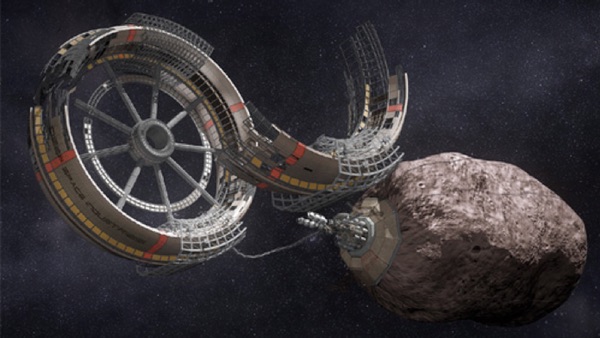 The future potential of additive manufacturing in space? (credit: Deep Space Industries) |
